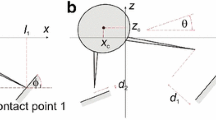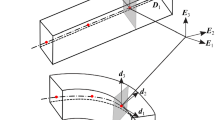Abstract
This paper is concerned with the dynamic analysis of flexible, nonlinear multi-body systems undergoing contact involving friction and rolling. A continuous friction law is used to model the friction forces between contacting bodies. This avoids the numerical problems associated with the discontinuity inherent to Coulomb's friction law and eliminates the need for different sets of equations modeling sliding and rolling as distinct phenomena. On the other hand, continuous friction laws eliminate specific physical phenomena implied by Coulomb's friction law. The condition of vanishing relative velocity between two contacting bodies is not possible: sticking or rolling are replaced by creeping with a small relative velocity. Discrete events such as transition from slipping to rolling or rolling to slipping are eliminated, together with the high frequency phenomena they are likely to cause. The computational issues associated with the continuous friction law and with the enforcement of the non-holonomic rolling constraint are addressed in this paper. This work is developed within the framework of energy preserving and decaying time integration schemes that provide unconditional stability for nonlinear, flexible multi-body systems undergoing contact involving friction and rolling.
Similar content being viewed by others
References
Kane, T.R., 'Impulsive motions', J. Appl. Mech. 15, 1962, 718–732.
Haug, E.J., Wehage, R. and Barman, N.C., 'Design sensitivity analysis of planar mechanism and machine dynamics', ASME J. Mech. Design 103, 1981, 560–570.
Khulief, Y.A. and Shabana, A.A., 'Dynamic analysis of constrained systems of rigid and flexible bodies with intermittent motion', ASME J. Mech., Transmissions, Automat. Design 108, 1986, 38–44.
Kane, T.R., Dynamics, Holt, Rinehart and Winston, New York, 1968.
Khulief, Y.A. and Shabana, A.A., 'A continuous force model for the impact analysis of flexible multi-body systems', Mech. Mach. Theory 22, 1987, 213–224.
Lankarani, H.M. and Nikravesh, P.E., 'A contact force model with hysteresis damping for impact analysis of multi-body systems', J. Mech. Design 112, 1990, 369–376.
Cardona, A. and Gérardin, M., 'Kinematic and dynamic analysis of mechanisms with cams', Comput. Methods Appl. Mech. Engrg. 103, 1993, 115–134.
Timoshenko, S.P. and Gere, J.M., Theory of Elastic Stability, McGraw-Hill, New York, 1961.
Hunt, K.H. and Crossley, F.R.E., 'Coefficient of restitution interpreted as damping in vibroimpact', J. Appl. Mech. 112, 1975, 440–445.
Bauchau, O.A., 'Analysis of flexible multi-body systems with intermittent contacts', Multibody System Dynamics, 1999, submitted.
Pfeiffer, F. and Glocker, C., Multi-Body Dynamics with Unilateral Contacts, John Wiley & Sons, New York, 1996.
Rabinowicz, E., Friction and Wear of Materials, 2nd edition, John Wiley & Sons, New York, 1995.
Oden, J.C. and Martins, J.A.C., 'Models and computational methods for dynamic friction phenomena', Comput. Methods Appl. Mech. Engrg. 52, 1985, 527–634.
Dahl, P.R., 'Solid friction damping of mechanical vibrations', AIAA J. 14, 1976, 1675–1682.
Baumeister, T., Avallone, E.A. and Baumeister III, T. (eds), Marks' Mechanical Engineers Handbook, McGraw-Hill, New York, 1978.
Shigley, J.E. and Mischke, C.R., Mechanical Engineering Design, McGraw-Hill, New York, 1989.
Banerjee, A.K. and Kane, T.R., 'Modeling and simulation of rotor bearing friction', J. Guidance Control Dynamics 17, 1994, 1137–1151.
Cardona, A., Gérardin, M. and Doan, D.B., 'Rigid and flexible joint modelling in multi-body dynamics using finite elements', Comput. Methods Appl. Mech. Engrg. 89, 1991, 395–418.
Mitiguy, P.C. and Banerjee, A.K., 'Efficient simulation of motion involving Coulomb friction', in Proceedings of the 16th Biennal Conference on Mechanical Vibration and Noise, Sacramento, CA, September 14–17, 1997.
Bauchau, O.A. and Theron, N.J., 'Energy decaying schemes for nonlinear elastic multi-body systems', Comput. & Structures 59, 1996, 317–331.
Bauchau, O.A., 'Computational schemes for flexible, nonlinear multi-body systems', Multibody System Dynamics 2, 1998, 169–225.
Bottasso, C.L. and Borri, M., 'Energy preserving/decaying schemes for non-linear beam dynamics using the helicoidal approximation', Comput. Methods Appl. Mech. Engrg. 143, 1997, 393–415.
Bottasso, C.L. and Borri, M., 'Integrating finite rotations', Comput. Methods Appl. Mech. Engrg. 164, 1998, 307–331.
Farin, G.E., Curves and Surfaces for Computer Aided Geometric Design, third edition, Academic Press, Boston, 1992.
Srnik, J. and Pfeiffer, F., 'Dynamics of CVT chain drives: Mechanical model and verification', in Proceedings of the 16th Biennal Conference on Mechanical Vibration and Noise, Sacramento, CA, September 14–17, 1997.
Kane, T.R. and Levinson, D.A., Dynamics: Theory and Applications,McGraw-Hill, New York, 1985.
Author information
Authors and Affiliations
Rights and permissions
About this article
Cite this article
Bauchau, O. On the Modeling of Friction and Rolling in Flexible Multi-Body Systems. Multibody System Dynamics 3, 209–239 (1999). https://doi.org/10.1023/A:1009883931415
Issue Date:
DOI: https://doi.org/10.1023/A:1009883931415




